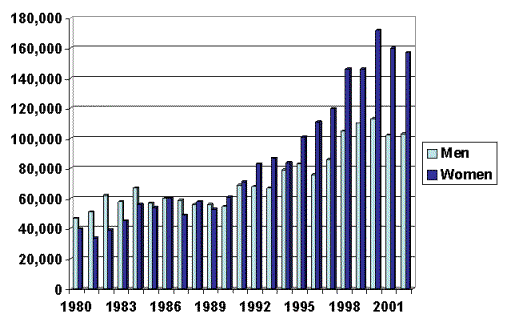 |
|
 |
 |
 |
Fact Sheets and At–a–Glance Reports
Pulmonary Hypertension Fact Sheet
This document is also available in
Portable
Document Format (PDF–61K).
Learn more about
PDFs.
Annual number of
hospitalizations among persons with pulmonary hypertension, United States,
1980–2002

Source: CDC, National Hospital Discharge Survey.
[A
text version of this
graphic is also available.]
Facts on Pulmonary Hypertension
- Pulmonary hypertension is
a rare lung disorder in which the blood pressure in the pulmonary artery
rises far above normal levels, usually with no apparent reason.
- Symptoms include chronic
fatigue, shortness of breath (dyspnea), chest pain (angina), palpitations, fainting,
swollen ankles and legs (edema), and fluid in the abdomen (ascites). These
are also symptoms for other diseases such as congestive heart failure;
therefore, physicians should rule out other diseases before making a
diagnosis of pulmonary hypertension.
- Pulmonary hypertension
may develop after pregnancy, valvular heart diseases, chronic thromboembolic
disease, lung diseases, liver diseases, sleep–disordered breathing and
hypoxemia, lupus, scleroderma, rheumatoid arthritis, vasculitis, or
human immunodeficiency virus (HIV) infection.
- In 2002, there were 15,668
deaths and 260,000 hospital visits among persons with pulmonary
hypertension.
- Among 807,000 patients
hospitalized with pulmonary hypertension as one of the diagnoses between
2000 and 2002, 61% were women and 34% were younger than age 65.
- It is unclear whether pulmonary hypertension is truly rare or whether
pulmonary hypertension is undetected and under–reported. At present
there are no statistical data to determine how many people currently
have pulmonary hypertension in the United States or how many new cases
are diagnosed each year.
- Increases in hospitalizations for persons with pulmonary hypertension
and increases in death rates for women, African–Americans, and the
elderly with pulmonary hypertension during the past two decades may
reflect an increase in physician awareness of the disease rather than a
growing epidemic of pulmonary hypertension.
- During the past decade, advances have occurred in knowledge about the
evaluation and diagnosis of several different types of pulmonary
hypertension and in the treatment of pulmonary arterial hypertension.
CDC's Public Health Efforts
CDC currently funds health
departments in 32 states and the District of Columbia to develop effective
strategies to reduce the burden of cardiovascular diseases and related risk
factors with an overarching emphasis on heart healthy policies and physical
and social environmental changes. Through these state programs, CDC aims to
reduce disparities in treatment, risk factors, and disease; delay the onset
of disease; postpone death from cardiovascular disease; and reduce disabling
conditions. For more information on CDC's State Heart Disease and Stroke
Prevention Program, please visit our Web site at http://www.cdc.gov/cvh/state_program/index.htm.
For More Information
More information on
pulmonary hypertension can be obtained from the following CDC partners:
References
- National Heart, Lung, and Blood Institute. Primary
pulmonary hypertension. Bethesda, MD: US Department of Health and Human
Services; November 1996. NIH Publication No. 96–3291.
- Centers for Disease Control and Prevention. Pulmonary
Hypertension Surveillance—United States, 1980–2002. In: Surveillance
Summaries, 2005. MMWR 2005;54(No. SS–5).
- McLaughlin VV, Presberg KW, Doyle RL, et al. Prognosis of
pulmonary arterial hypertension: ACCP evidence–based clinical practice
guidelines. Chest 2004;126(Suppl 1):78S–92S.
- Hoepner MM, Galie N, Simonneau G, Rubin LJ. New treatments
for pulmonary arterial hypertension. Am J Respr Crit Care Med
2002;165:1209–1216.
- Simonneau G, Galie N, Rubin LJ, et al. Clinical
classification of pulmonary hypertension. J Am Coll Cardiol 2004;43(Suppl):5S–12S.
- Klepetko W, Mayer E, Sandoval J, et al. Interventional and
surgical modalities of treatment with pulmonary arterial hypertension. J Am Coll Cardiol
2004;43(Suppl S):73S–80S.
- Barst RJ, McGoon M, Torbicki A, et al. Diagnosis and
differential assessment of pulmonary arterial hypertension. J Am Coll
Cardiol 2004;43(Suppl S):40S–47S.
- Farber HW, Loscalzo J. Mechanisms of disease: pulmonary
arterial hypertension. N Engl J Med 2004;351:1655–1665.
Return to top of page
*Links to non–Federal organizations are provided solely as a service to our users. Links do not constitute an endorsement of any organization by CDC or the Federal Government, and none should be inferred. The CDC is not responsible for the content of the individual organization Web pages found at this link.
Date last reviewed:
05/12/2006
Content source: Division for Heart Disease and Stroke
Prevention,
National Center for Chronic Disease Prevention and
Health Promotion |
 |